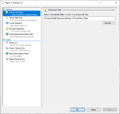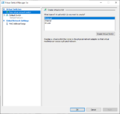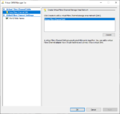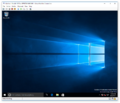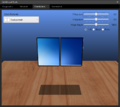Hyper-V
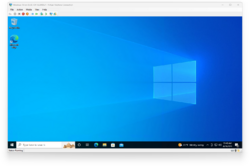 Hyper-V running Windows 10, version 22H2 | |
| Type | Hypervisor |
|---|---|
| Developer(s) | Microsoft Corporation |
| Host platform | Windows (x64/ARM64) |
| Guest platform | x86/x64/ARM64 (virtualized) |
| Initial release version | 6.0.6001.18000 (2008-02-27) |
| Latest release version | 10.0.26100.1 (2024-10-01) |
Hyper-V (codenamed Viridian) is a native hypervisor for AMD64 and ARM64 platforms developed by Microsoft, which is available as an optional Microsoft Windows component. It allows creating virtual machines on a Windows host and managing them over RDP. The Hyper-V virtualization stack is also used to implement other Windows features such as Windows Subsystem for Linux or Windows Defender's Virtualization-Based Security and Application Guard features.
It was introduced as part of the x64 version of Windows Server 2008 as the successor to Microsoft Virtual Server, the server counterpart of the Virtual PC application acquired from Connectix. Since Windows 8, it is also included with Pro and higher client editions. A standalone version of Windows Server Core called Hyper-V Server, which only supported the Hyper-V server role, was also offered by Microsoft free of charge at one point.
Unlike other virtualization software available for Windows, Hyper-V uses a type-1 (native) hypervisor, which is initialized at startup and lets the host operating system itself run under the hypervisor in a special "root" partition. Other solutions, such as VirtualBox or VMware, typically use type-2 hypervisors that run on top of a conventional operating system. This meant that the two types of hypervisors could not co-exist on a single machine before the introduction of the Windows Hypervisor Platform, a low-level API which allows third party software to leverage the Hyper-V hypervisor.
Display output from virtual machines is provided via the Remote Desktop Protocol; the hypervisor includes an "enhanced session mode" that offers additional VM display capabilities through a dedicated driver built into the operating system and by having the RDP protocol interface with the Windows session manager.
Hyper-V Server[edit | edit source]
Hyper-V Server is a standalone version of Windows Server Core, which only supports the Hyper-V in addition to the base file and storage role. It is the only version of Microsoft Windows to be available for download free of charge to end users.
The final version released is Hyper-V Server 2019, as the edition was later discontinued in 2021 in favor of Azure Stack HCI.[1]
The following versions of Hyper-V Server were released:
| Name | Release date | Support end date |
|---|---|---|
| Hyper-V Server 2008 | 2008-10-02 | 2020-01-14 |
| Hyper-V Server 2008 R2 | 2009-10-22 | 2020-01-14 |
| Hyper-V Server 2012 | 2012-10-30 | 2023-10-10 |
| Hyper-V Server 2012 R2 | 2013-11-25 | 2023-10-10 |
| Hyper-V Server 2016 | 2016-10-15 | 2027-01-12 |
| Hyper-V Server 2019 | 2018-11-13 | 2029-01-09 |
|
Legend:
Old version
Older version, still supported
Current stable version
Latest preview version
Future release
| ||
Windows Hypervisor Platform[edit | edit source]
The Windows Hypervisor Platform is a user-mode API that is used to manage Hyper-V hypervisor partitions, and was first introduced as part of the Windows 10 April 2018 Update. It is primarily used by third-party virtualization software such as VirtualBox or VMware Workstation,[2][3] as they cannot directly use hardware virtualization extensions when Hyper-V is enabled. It is also supported by QEMU and the Android Emulator as an acceleration engine.
It is a low-level interface that only exposes the virtual CPU, memory and optionally the interrupt controller, leaving the implementation of necessary hardware components and system software up to the consumer. This is in contrast with Host Compute System, a high-level API used by WSL2 and Microsoft Emulator, which effectively provides fully-implemented headless Hyper-V virtual machines.
Virtual Machine Platform[edit | edit source]
Virtual Machine Platform is an optional Windows feature, which enables selected parts of the Hyper-V infrastructure. It is a dependency of several Windows features and other Microsoft products, including:
- Windows Subsystem for Linux 2
- Windows Subsystem for Android
- Microsoft Emulator
Microsoft Emulator[edit | edit source]
A watered-down version of the hypervisor (dubbed the X Device Emulator (XDE), later renamed to Microsoft Emulator) that simulates a physical device was also produced - originally a fork of Virtual PC used to emulate Windows CE-based operating systems like Windows Phone 7, and later ported to support Windows Phone 8.x and Windows 10 Mobile, it has since been expanded to a multitude of different purposes such as replicating the functionality of the HoloLens head-mounted display in virtual form and self-hosting Windows 10X builds.
Supported guest operating systems[edit | edit source]
This is a definitive list of officially supported operating systems that can run under Hyper-V, as of Windows Server 2025.[4][5]
- Windows 7 with Service Pack 1 and above
- Windows Server 2008 with Service Pack 2 and above
- Most Linux distributions
Deprecated operating systems[edit | edit source]
The following operating systems are supported on older versions of Hyper-V on older host Windows systems, but are not supported in the latest Windows 11 version of Hyper-V.[6][7]
- Windows 2000 Server with Service Pack 4 (support removed on Windows 8 and Windows Server 2012)
- Windows XP with Service Pack 2 or Windows XP Professional x64 Edition with Service Pack 2 (support removed on Windows 10 and Windows Server 2016)
- Windows Server 2003 with Service Pack 2 (support removed on Windows 10 and Windows Server 2016)
- Windows Vista with Service Pack 2 (support removed on Windows 11)
- Windows Small Business Server 2011 (support removed on Windows 11)
- Windows Home Server 2011 (support removed on Windows 11)
- Windows MultiPoint Server 2011 (support removed on Windows 8 and Windows Server 2012)
Gallery[edit | edit source]
Hyper-V[edit | edit source]
Hyper-V booting Windows 8.1 build 9471
Hyper-V running Windows 10 build 10565
XDE/Microsoft Emulator[edit | edit source]
XDE running Windows 10 Mobile build 10030
Microsoft Emulator running Windows 10X build 19578
References[edit | edit source]
- ↑ https://www.theregister.com/2021/08/31/hyper_v_server_discontinued/
- ↑ Zongmin. VMware Workstation 15.5 Now Supports Host Hyper-V Mode, VMware Workstation Zealot. 28 May 2020.
- ↑ Oracle. VirtualBox version 6.0 changelog, Oracle VM VirtualBox documentation. 18 December 2020.
- ↑ https://docs.microsoft.com/en-us/windows-server/virtualization/hyper-v/supported-windows-guest-operating-systems-for-hyper-v-on-windows
- ↑ https://docs.microsoft.com/en-us/windows-server/virtualization/hyper-v/supported-linux-and-freebsd-virtual-machines-for-hyper-v-on-windows
- ↑ https://docs.microsoft.com/en-us/previous-versions/windows/it-pro/windows-server-2008-R2-and-2008/cc794868(v=ws.10)
- ↑ https://docs.microsoft.com/en-us/previous-versions/windows/it-pro/windows-server-2012-R2-and-2012/dn792028(v=ws.11)




